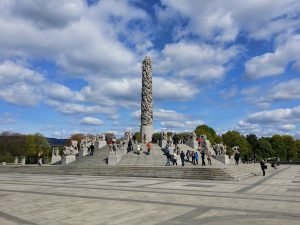
Norwegian: The Official Norway Country Language
Did you know that Norwegian is the official language of Norway? Discover the fascinating aspects of Norwegian as we delve into its rich history, unique dialects, and its importance in Norwegian culture.
Table of Contents
ToggleKey Takeaways:
- Norwegian is the official language of Norway.
- Explore the history and development of Norwegian.
- Learn about the Norwegian alphabet and vocabulary.
- Gain insight into the grammar rules of Norwegian.
- Discover the diverse range of Norwegian dialects.
Norwegian Language History
Embark on a journey through time as we delve into the captivating origins and evolution of the Norwegian language. Spanning centuries, Norwegian has undergone a fascinating transformation, shaped by a rich historical backdrop and various linguistic influences.
The roots of Norwegian can be traced back to Old Norse, the language spoken by the Vikings during the medieval period. As Norway gradually transitioned from a collection of small kingdoms to a unified nation, Old Norse developed into the distinct dialects that form the basis of modern Norwegian.
“The Norwegian language has been shaped by a multitude of factors, including its Viking heritage and interactions with neighboring countries,” says linguistic expert Dr. Maria Olsen.
Over the centuries, Norwegian has also been influenced by the languages of neighboring nations. The close proximity to Denmark and Sweden, for example, led to Danish and Swedish loanwords entering the Norwegian lexicon. Similarly, the influence of Low German can be seen in the dialects spoken in coastal areas.
During the 19th century, a movement known as the Norwegian language struggle took place, aiming to preserve and elevate Norwegian as a distinct language separate from Danish. This cultural revival contributed to the standardization of Norwegian and the establishment of two official written forms: Bokmål and Nynorsk.
Today, Norwegian stands as a testament to the fascinating interplay between history, culture, and language. It continues to evolve and adapt, reflecting the dynamic nature of Norwegian society.
Key Moments in Norwegian Language History
- The Viking Age (800-1050) marks the beginning of Old Norse, the precursor to modern Norwegian.
- The union between Norway and Denmark (1380-1814) leads to Danish influences on the Norwegian language.
- The Norwegian language struggle in the 19th century sparks efforts to establish Norwegian as a distinct language.
- The creation of Bokmål and Nynorsk as official written forms of Norwegian in the late 19th century.
| Period | Key Influences |
|---|---|
| Viking Age | Old Norse |
| Union with Denmark | Danish |
| 19th Century | Norwegian language struggle |
| Late 19th Century | Bokmål and Nynorsk |
Through the ebb and flow of history and the influence of neighboring languages, Norwegian has emerged as a unique and vibrant language, embodying the spirit of Norway and its people.
Norwegian Alphabet and Vocabulary
When diving into the world of Norwegian language, it is essential to familiarize yourself with the unique characters and pronunciation of the Norwegian alphabet. Understanding the alphabet will help you navigate through written texts and assist in improving your language proficiency.
The Norwegian Alphabet
The Norwegian alphabet consists of 29 letters, including three additional characters: “Æ”, “Ø”, and “Å”. These letters have specific sounds and play a crucial role in distinguishing Norwegian words. Here is a table showcasing the Norwegian alphabet:
| Letter | Pronunciation |
|---|---|
| A | [ah] |
| B | [beh] |
| C | [seh] |
| D | [deh] |
| E | [eh] |
| F | [eff] |
| G | [geh] |
| H | [haw] |
| I | [ee] |
| J | [yot] |
| K | [kaw] |
| L | [ell] |
| M | [em] |
| N | [en] |
| O | [oh] |
| P | [peh] |
| Q | [koo] |
| R | [er] |
| S | [ess] |
| T | [teh] |
| U | [oo] |
| V | [veh] |
| W | [dawbuhlehveh] |
| X | [eks] |
| Y | [u] |
| Z | [seh-tah] |
| Æ | [ehh] |
| Ø | [uh] |
| Å | [oh] |
Vocabulary in Norwegian
The Norwegian vocabulary is a beautiful mix of words influenced by Old Norse, modern Norwegian, and loanwords from other languages. By expanding your vocabulary, you can express yourself more precisely and fluently. Here are some common Norwegian words and phrases:
- Hei – Hello
- Takk – Thank you
- Hva – What
- Jeg – I
- Si – Say
- Du – You
- Hvordan – How
- Norsk – Norwegian
- God morgen – Good morning
- Lærer – Teacher
Remember, building your vocabulary takes time and practice. Immerse yourself in the language by reading Norwegian books, watching Norwegian films, and engaging in conversations with native speakers.
Norwegian Grammar Rules
Gaining insight into the grammar rules of the Norwegian language is essential for effective communication. Understanding the rules of noun genders, verb conjugations, sentence structure, and more will help you navigate the intricacies of Norwegian grammar.
In Norwegian, like many other languages, nouns have genders. There are three genders: masculine, feminine, and neuter. It’s important to learn the gender of each noun, as it affects the articles, adjectives, and pronouns used with them.
Verb conjugations in Norwegian vary depending on the tense, mood, and subject of the sentence. Regular verbs follow predictable conjugation patterns, while irregular verbs have unique forms that must be memorized. Mastering verb conjugations will enable you to express actions accurately and confidently.
Sentence structure in Norwegian follows a subject-verb-object pattern, similar to English. However, there are some differences to be aware of. Adjectives usually follow the noun they modify, and the definite article is added as a suffix to the noun itself, rather than using a separate word.
Word Order and Negation
In Norwegian, word order plays a crucial role in conveying meaning. Placing words in different positions within a sentence can change the emphasis or highlight specific information. Negation is typically expressed by using “ikke” after the verb, although there are other ways to negate a sentence depending on the context.
Example: Hun spiser ikke brød. (She does not eat bread)
Example: Jeg har aldri vært i Oslo. (I have never been to Oslo)
Furthermore, Norwegian grammar includes definite and indefinite forms, as well as possessive pronouns and adjective agreement. Learning these additional aspects will enable you to construct grammatically correct and coherent sentences.
By mastering the grammar rules of the Norwegian language, you’ll be better equipped to communicate effectively, express your thoughts, and engage in meaningful conversations with native speakers.
Norwegian Dialects
Norway is known for its unique linguistic landscape, which is shaped by a diverse range of dialects spoken throughout different regions of the country. These dialects vary in pronunciation, vocabulary, and grammar, adding richness and complexity to the Norwegian language.
One of the most well-known dialects is Bergensk, spoken in Bergen and the surrounding areas. This dialect is characterized by its distinctive melody and intonation, making it easy to identify for those familiar with Norwegian dialects. Another prominent dialect is Trøndersk, spoken in the central region of Trøndelag. Trøndersk has a musical quality and is often associated with a friendly and welcoming demeanor.
Nordlending is the dialect spoken in the northern parts of Norway, including Tromsø and Bodø. It has a distinct pronunciation and vocabulary, influenced by the Sami language. In contrast, Oslo-dialekt, the dialect spoken in the capital city of Oslo, is considered more standard and closer to the written form of Norwegian.
Each Norwegian dialect reflects the cultural heritage, history, and geography of the region it originates from. They serve as a testament to the rich diversity within the Norwegian language and add depth to the country’s linguistic tapestry.
While these are just a few examples, there are numerous other dialects spoken in different parts of Norway. Exploring the unique characteristics of each dialect offers insights into the local culture and traditions.
| Dialect | Region | Distinctive Features |
|---|---|---|
| Bergensk | Bergen and surrounding areas | Distinct melody and intonation |
| Trøndersk | Trøndelag | Musical quality and friendly tone |
| Nordlending | Northern parts of Norway | Influenced by the Sami language |
| Oslo-dialekt | Oslo | Closer to standard Norwegian |
As you delve into the fascinating world of Norwegian dialects, you’ll discover the intricacies and charm of each accent and expression. Whether you’re interacting with locals or immersing yourself in Norwegian literature and media, understanding the nuances of these dialects will enhance your language skills and appreciation of Norwegian culture.
Learning Norwegian: NLS Norwegian Language School
If you’re interested in learning Norwegian, look no further than the NLS Norwegian Language School. With our comprehensive language programs, qualified instructors, and effective teaching methods, we can help you master the Norwegian language in no time.
At NLS, we understand that learning a new language can be challenging, but our experienced instructors are here to guide you every step of the way. They possess in-depth knowledge of the Norwegian language and culture, ensuring an immersive and authentic learning experience.
Our language programs at NLS cater to learners of all levels, from beginners to advanced. Whether you’re starting from scratch or looking to further improve your existing language skills, we have the right course for you.
With small class sizes, you’ll receive personalized attention and ample opportunities to practice conversational Norwegian. Our interactive lessons, supplemented with engaging audio and visual materials, make the learning process fun, interactive, and effective.
At NLS, we believe in the importance of practical application. That’s why we emphasize real-world language usage, providing you with opportunities to apply your newfound knowledge in real-life situations. From ordering at restaurants to engaging in everyday conversations, you’ll gain the confidence to communicate fluently in Norwegian.
Why Choose NLS Norwegian Language School?
“I enrolled in NLS Norwegian Language School with the goal of learning Norwegian **and diving into Norwegian culture**. The school exceeded my expectations with **its immersive teaching style and knowledgeable instructors**. I highly recommend NLS to anyone looking to learn Norwegian!”
When you choose NLS, you choose a supportive and inclusive learning environment. Our friendly staff and fellow students create a welcoming community where you can feel comfortable expressing yourself and practising your language skills.
Furthermore, NLS offers flexible scheduling options to accommodate your busy lifestyle. Whether you prefer intensive courses or a more relaxed pace, we have both full-time and part-time programs available.
So, if you’re ready to embark on an exciting language learning journey and immerse yourself in the beauty of the Norwegian language and culture, join the NLS Norwegian Language School today!
| Benefits of Choosing NLS | Testimonials |
|---|---|
|
|
Conclusion
In conclusion, the Norwegian language plays a pivotal role in understanding the rich culture, history, and people of Norway. With its diverse range of dialects, the Norwegian language reflects the unique linguistic landscape of the country. Exploring the Norwegian vocabulary, influenced by old Norse, modern Norwegian, and loanwords from other languages, can open up a world of opportunities for language learners.
Whether you’re fascinated by the complexity of Norwegian grammar rules or simply looking to broaden your linguistic horizons, learning Norwegian can be an enriching experience. It not only allows you to communicate effectively with locals but also deepens your understanding of Norwegian culture and heritage.
If you’re eager to embark on a Norwegian language journey, consider enrolling in the NLS Norwegian Language School. Their comprehensive language programs, led by qualified instructors, provide an ideal environment for mastering Norwegian. Immersing yourself in the Norwegian language will give you a deeper appreciation for the nuances of the language and the country itself.
FAQ
What is the official language of Norway?
The official language of Norway is Norwegian.
What is the history of the Norwegian language?
The Norwegian language has its roots in Old Norse and has evolved over the centuries with influences from neighboring languages.
What is the Norwegian alphabet like?
The Norwegian alphabet consists of 29 letters, including unique characters like æ, ø, and å.
What are some common Norwegian vocabulary words?
Norwegian vocabulary includes words influenced by Old Norse, modern Norwegian, and loanwords from other languages.
What are the grammar rules in Norwegian?
Norwegian grammar includes noun genders, verb conjugations, sentence structure, and other essential elements.
What are the different dialects of Norwegian?
Norway has a diverse range of dialects with variations in pronunciation, vocabulary, and grammar across different regions.
How can I learn Norwegian?
Consider enrolling in the NLS Norwegian Language School, which offers comprehensive language programs taught by qualified instructors.
If you want to learn Norwegian, you can register for classes here. We look forward to hearing from you and helping you become fluent in Norwegian.




